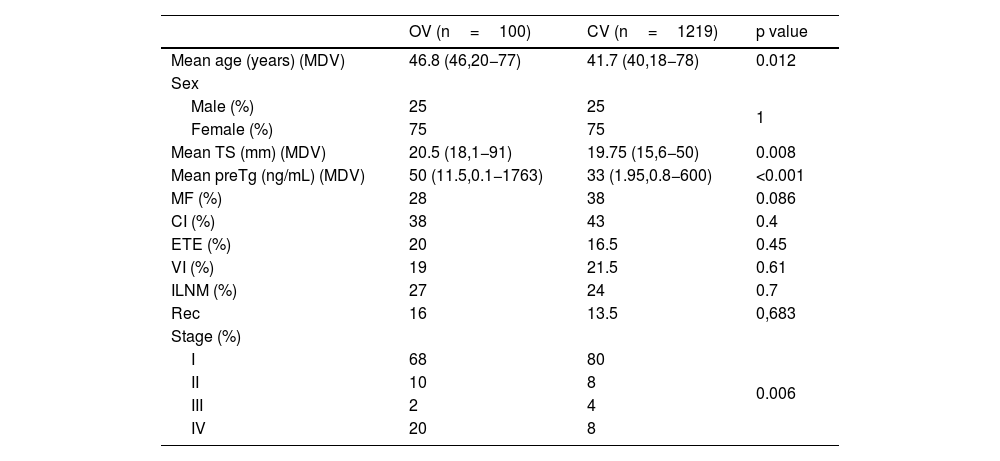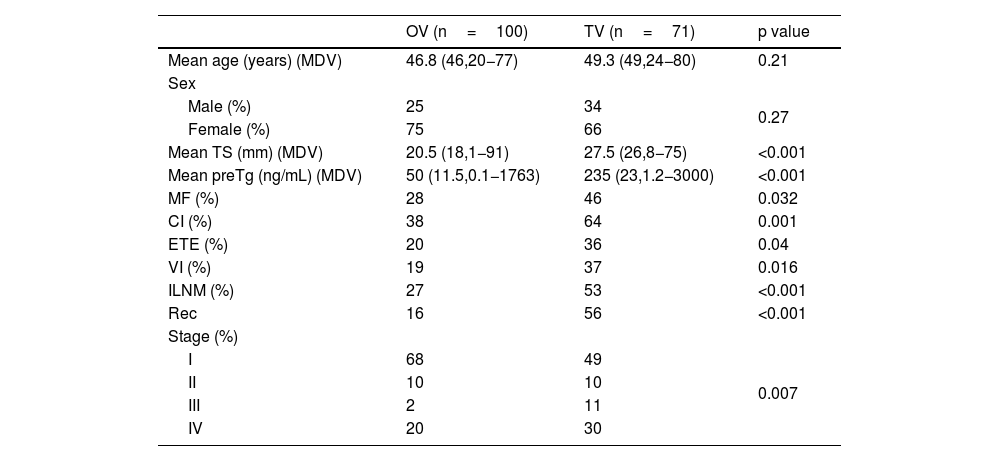Papillary thyroid cancer (PTC) has many variants and most of them are mild tumors. Oncocytic variant (OV) is a rare subtype of PTC. There are controversial results about its prognosis in the literature. We investigated its aggressivity and clinical course by comparing it with classical variant (CV) and tall cell variant (TV) of PTC over a stage-matched design.
Material and MethodsPure 100 OV, 71TV and 1219 CV were included in this retrospective cohort study. OV was compared with CV and TV according to independent prognostic parameters. OV was also compared stage by stage with CV and TV for recurrence.
ResultsMean age was 46,8 years and male/female ratio 25/75 for OV. The recurrence rates in our study were 16% in OV, 13,5% in CV and 56% in TV. There is a statistically significant difference according to recurrence between stage I and stage IV OV and CV (p=0.023, p=0.03, respectively). There is also a statistically significant difference between stage I and stage IV OV and TV according to recurrence (p=0.001, p=0.024, respectively). OV can be supposed to behave between CV and TV, but very closer to CV.
ConclusionsOV seems to be slightly more aggressive than CV. Despite an inadequate sample size for stage II and III, our findings imply an increased recurrence risk for OV than CV at the advanced stages (stage III and IV) and CV has an unfavorable prognosis than OV at early stages (stage I and II) according to stage-matched model.
El cáncer papilar de tiroides (CPT) tiene diferentes variantes y la mayoría de ellas presentan diferencias sutiles. La variante oncocítica (VO) es un subtipo poco frecuente de CPT y en la literatura existen resultados controvertidos sobre el pronóstico de esta variante. Investigamos su agresividad y curso clínico comparándolo con la variante clásica (VC) y la variante de células altas (CA) de CPT en diferentes estadios.
Material y métodosEn este estudio de cohortes retrospectivo se incluyeron: 100 muestras simples de VO, 71 de CA y 1219 de VC. Las muestras VO se compararon con las VC y las de CA sobre la base de parámetros de pronóstico independientes. La recurrencia de la VO también se comparó estadio por estadio con la VC y CA.
ResultadosLa edad media fue de 46,8 años y la relación hombres/mujeres 25/75 para la VO. Las tasas de recurrencia en nuestro estudio fueron de 16% en VO, 13,5% en VC y 56% en CA. Existe una diferencia estadísticamente significativa con respecto a la recurrencia entre el estadio I y el estadio IV comparando la VO y la VC (p=0,023, p=0,03, respectivamente). También hay una diferencia estadísticamente significativa con respecto a la recurrencia entre el estadio I y el estadio IV comparando la VO y la CA (p=0,001; p=0,024, respectivamente). Se puede suponer que la VO tiene un comportamiento entre la VC y la CA, pero muy cercana a la CA.
ConclusiónLa VO parece ser un poco más agresiva que la VC. A pesar de un tamaño de muestra inadecuado para el estadio II y III, nuestros hallazgos implican un mayor riesgo de recurrencia para la VO que la VC en los estadios avanzados (estadios III y IV) y la VC tiene un pronóstico desfavorable que VO en estadios precoces (estadios I y II) según el modelo de estadio pareado.
Article

Revista Española de Medicina Nuclear e Imagen Molecular (English Edition)











